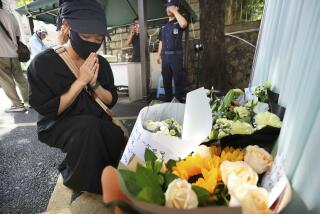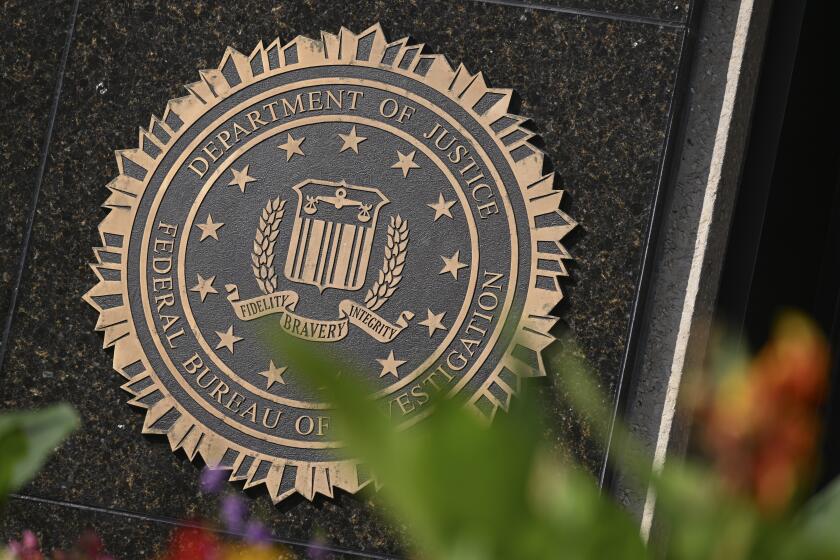Terrorists’ Surveillance Effort May Be Broader
Al Qaeda surveillance experts personally cased financial targets in New York and probably Washington and New Jersey in 2001 for potential terrorist attack, and were helped by facilitators who may still be hiding in the United States, U.S. officials said Saturday.
Two senior federal law enforcement officials said Abu Eisa al Hindi, an alleged senior Al Qaeda operative arrested last week in London, headed a small surveillance squad that participated in a well-organized effort to compile detailed building surveys of the New York Stock Exchange and Citigroup Inc. in New York, and possibly of the World Bank and International Monetary Fund in Washington and insurer Prudential Financial Inc. in New Jersey.
The building surveys circulated among Al Qaeda cells in Pakistan, Britain and perhaps the United States and elsewhere, the officials said.
Detailed assessments of those buildings were found during a raid in Pakistan last month that, when combined with other information, prompted the U.S. government to raise the terrorism alert Aug. 1, Bush administration officials have said.
Of particular concern, U.S. officials said Saturday, is whether Al Qaeda operatives connected to that surveillance effort remain in the United States. They said they were also concerned about the whereabouts of others who may have been trained as logistical experts by Al Qaeda to provide its “operational” soldiers with money, transportation, fake identification and places to hide, perhaps for years at a time.
“We have been trying to determine who was here, who was doing surveillance, and any contacts they may have had here and abroad,” one senior federal law enforcement official said. “We are looking at who they may have had contacts with here and if they still have contacts, their travel patterns, how they arrived here. We are also looking to develop how and when the surveillance was conducted to develop leads from that.”
The officials’ comments shed light on their view of how the surveillance mission operated, and also on their increased concerns that others were involved.
Previously, officials had said they believed Al Hindi had carried out surveillance of U.S. financial institutions before the Sept. 11 attacks. It was unclear whether he had support in the U.S. from other operatives.
Citing information in the recent report of the Sept. 11 commission, counter-terrorism officials said that Al Hindi’s surveillance mission had been ordered by accused Sept. 11 mastermind Khalid Shaikh Mohammed, a senior Al Qaeda leader.
On Saturday, the FBI, state and local authorities continued their search for clues as to how many men were sent on the mission by Mohammed in 2001, how long they stayed and, of most concern, whether some of the men were still in the United States and plotting to launch a potentially devastating attack during the presidential election campaign.
The senior official said the FBI and CIA were working closely with Pakistani and British authorities in trying to flush information from more than 20 Al Qaeda operatives captured in recent weeks, including several men believed to be senior members of the terrorist network.
The FBI and local authorities, particularly a massive deployment of New York police, continued to seek and review surveillance videos from the five sites dating back to 2001. They were also conducting interviews, using secret Foreign Intelligence Surveillance Act wiretaps and using other means to track down leads in several cities besides New York, Newark and Washington.
One of the authorities said it was more likely that the men who compiled the surveillance files, which were discovered last month after the arrest of an Al Qaeda computer expert in Pakistan, left the country after completing their mission and returned to Pakistan or Afghanistan or elsewhere, where the files were then copied and circulated.
Other teams of Al Qaeda operatives were probably sent to the U.S. separately, to protect the security of the terrorist mission, the law enforcement official said. He said authorities based that conclusion on information coming from captured Al Qaeda operatives, on intelligence scooped by U.S., British and Pakistani authorities and on Al Qaeda’s own writings, in which the group teaches its senior planners how to compartmentalize an operation so that if one operative is captured, he will not know the whereabouts or activities of others and cannot give them up in interrogations.
Authorities also believe Osama bin Laden may have been involved personally in dispatching the men, particularly Al Hindi, to the U.S. Al Hindi is also known by the names Abu Musa al Hindi and, in the Sept. 11 commission report, as Issa al Britani.
In Pakistan, government intelligence sources Saturday disclosed the capture of an additional senior Al Qaeda operative who knew Bin Laden and was linked to assassination attempts on Pakistan’s president, Reuters news service reported.
Qari Saifullah Akhtar, described to Reuters by one source as “operational head of Al Qaeda in Pakistan,” was arrested in Dubai on Friday after Pakistan had requested his detention, and was handed over to authorities in Islamabad on Saturday.
Despite getting troves of information recently from captured Al Qaeda members overseas, the FBI and other authorities said they were getting frustrated and angry Saturday by the fact that some of the information was becoming public.
“We are working with our partners abroad,” the federal senior law enforcement official said. “But there is some concern that some of this stuff that’s getting out there [to the public] is adversely affecting what we are doing here.”
The official said he could not elaborate except to say that specific leads had been compromised because the suspects now knew the authorities were pursuing them.
The federal senior law enforcement official said it was difficult to say how many Al Qaeda operatives may have been in the U.S., “because that’s what they are trying to ascertain.”
A second senior law enforcement official said the state and local police and FBI were working well together.
“The flow of information and cooperation between them is better than it was a year ago. Things are better, but we still have a ways to go. All of our eyes and ears are out there,” the official said. “There is a sense of urgency to this, but there has been a sense of urgency to all of this since Sept. 11. It ebbs and flows, and it is at one of those peaks now, and we are probably going to stay that way through the election and beyond.”
The authorities said they believed Mohammed, who has been in U.S. custody at an undisclosed location for nearly 18 months, oversaw a long-standing and near-obsessive effort to get Al Qaeda operators into the United States to launch attacks, including through Mexico and the huge, often unpatrolled and porous southern border.
Adding to their concerns was that another of Bin Laden’s most senior aides in U.S. custody, known as Abu Zubeida, was intensely interested in getting Al Qaeda operators into the U.S. in 2001 and probably earlier.
Zubeida -- considered to have been Al Qaeda’s travel agent at the time -- is thought to have often provided the operators with money and logistical help to travel back to their home countries after training in Afghanistan. Some were trained as attackers and members of operational squads, but far more were instructed in how to provide logistical and financial help for Al Qaeda soldiers they may never come into contact with, said the authorities.
The capture in Dubai of Akhtar, identified by Reuters as leader of the radical Islamic group Harkat-ul-Jihad-i-Islami, was the latest breakthrough in a broadening offensive against terrorist groups in Pakistan that has netted more than 20 suspects in recent weeks, including computer engineer Mohammed Naeem Noor Khan.
Reuters reported that one intelligence source said Khan had e-mailed Al Qaeda comrades while in custody as part of a sting by security agencies, but that his name appeared in U.S. newspapers, which may have compromised the operation.
Akhtar was with Bin Laden and Taliban leader Mullah Mohammed Omar in Afghanistan during the U.S.-led war against the hard-line Islamic militia late in 2001. He fled first to Saudi Arabia and then to the United Arab Emirates, Reuters said.
The news agency said he was also allegedly linked to two assassination attempts on Pakistani President Pervez Musharraf in December and a bid to kill Prime Minister-designate Shaukat Aziz in July.
As officials continued to track Al Hindi’s trail in the United States, President Bush said in his weekly radio address that the elevation of the official threat level this week in New York, New Jersey and Washington, D.C., was “a grim reminder of the dangers we continue to face.”
Bush said his administration had “pursued terrorists across the world, destroying their leadership and denying them sanctuary.” He said the administration was “working with other governments to break up terror cells and stop planned attacks, on virtually every continent.”
Times staff writer Paul Richter contributed to this report from Washington.
More to Read
Sign up for Essential California
The most important California stories and recommendations in your inbox every morning.
You may occasionally receive promotional content from the Los Angeles Times.










